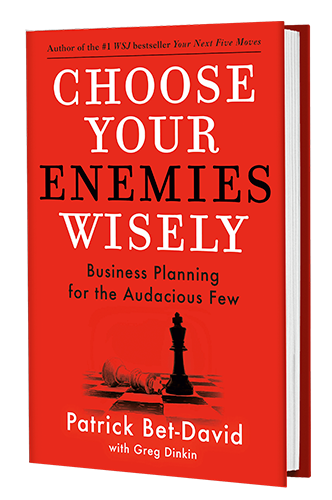Choose Your Enemies Wisely

🚀 The book in 1 sentence
“Choose Your Enemies Wisely” by Patrick Bet-David is a strategic guide that delves into the art of assessing adversaries and tactically choosing conflicts in business and personal life.
🎨 Impression
Patrick Bet-David, a renowned entrepreneur and business strategist, offers readers a unique blend of advice derived from his extensive experience in building businesses and managing personal relationships. In “Choose Your Enemies Wisely,” he explores the nuances of conflict resolution, negotiation, and strategic planning. The book is structured to help readers understand not just how to choose their battles, but also how to manage and resolve conflicts with minimal fallout, ensuring long-term success and stability.
👤 Who should read it?
- Entrepreneurs and business managers looking for strategic guidance on conflict management.
- Anyone involved in high-stakes negotiation and decision-making.
- Readers interested in personal development and effective communication skills.
- Fans of Patrick Bet-David’s motivational speaking and business insights.
⭐️ How the book impacted me:
- Enhanced my understanding of strategic decision-making in both business and personal contexts.
- Provided insights into the psychology of conflict and how understanding different perspectives can facilitate better outcomes.
- Motivated me to reassess how I approach potential conflicts and the criteria for engaging in them.
- Encouraged thoughtful consideration of long-term impacts when making decisions that involve confrontation.
💙 Favorite Quotes
“Choosing your enemies wisely isn’t about avoidance; it’s about recognition of the battles that truly matter.”
“Understanding your opponent is the first step to a victorious strategy.”
“Every conflict offers a mirror to our own desires, fears, and values.”
✍🏼 Detailed Chapter Notes:
- Chapter 1: Assessing the Battlefield - Patrick Bet-David introduces the importance of careful assessment before engaging in any conflict. He discusses how evaluating both the tangible and intangible elements of a potential battle can save resources and prevent unnecessary struggles. By using business analogies, Bet-David illustrates the strategic planning needed to understand the full scope of any confrontation, advocating for a methodical approach to conflict assessment.
- Chapter 2: The Psychology of Conflict - This chapter delves into the psychological underpinnings of conflict, emphasizing how personal biases and emotions can influence decision-making. Bet-David offers techniques for maintaining emotional detachment to make more rational choices. He explains how understanding the psychological drives of all parties involved can lead to more effective conflict management strategies.
- Chapter 3: Know Your Adversaries - Bet-David stresses the importance of knowing who you are up against. He provides methods for researching and understanding adversaries, which can reveal their strengths and weaknesses. This chapter helps readers develop a nuanced view of their opponents, which is critical for crafting tailored strategies in business and personal conflicts.
- Chapter 4: Choosing Your Battles - In this chapter, Bet-David discusses the crucial decision of whether or not to engage. He outlines specific criteria for determining the worthiness of a battle, considering both immediate and long-term implications. The focus is on choosing conflicts that align with overarching personal and professional goals, rather than being drawn into battles by pride or emotion.
- Chapter 5: Strategies for Engagement - Once the decision to engage has been made, Bet-David explores various engagement strategies. He compares direct confrontation with more subtle forms of engagement, such as influence and persuasion. This chapter provides readers with a toolkit for approaching conflicts in a way that maximizes the chances of a favorable outcome.
- Chapter 6: Negotiation Tactics - Focusing on negotiation, this chapter offers practical advice on how to negotiate effectively. Bet-David discusses how to prepare for negotiations, the importance of understanding the other party’s needs, and how to use leverage creatively. He also covers the psychological aspects of negotiation, teaching readers how to read cues and adjust tactics accordingly.
- Chapter 7: Managing Conflict - Bet-David provides strategies for managing ongoing conflicts. He emphasizes the importance of adaptability and resilience, offering tips on how to manage stress and uncertainty. The chapter also discusses ways to keep conflicts from escalating beyond control, maintaining focus on the desired outcomes.
- Chapter 8: Winning the Peace - Winning a conflict doesn’t end at the resolution of the immediate issues. This chapter discusses how to manage the aftermath of a conflict, including how to repair relationships and consolidate gains. Bet-David advises on how to build a sustainable peace, turning former adversaries into allies when possible.
- Chapter 9: Lessons from Defeat - Bet-David reflects on the valuable insights that can be gained from defeats. He encourages readers to adopt a growth mindset, analyzing losses to extract lessons that can lead to future successes. This chapter is about turning setbacks into setups for future victories by understanding and addressing the root causes of defeat.
- Chapter 10: Building Alliances - This chapter highlights the importance of building strategic alliances. Bet-David discusses how alliances can be a powerful tool in avoiding unnecessary conflicts and strengthening positions. He provides guidance on choosing the right allies and nurturing those relationships to ensure mutual benefits.
- Chapter 10: Building Alliances - This chapter highlights the importance of building strategic alliances. Bet-David discusses how alliances can be a powerful tool in avoiding unnecessary conflicts and strengthening positions. He provides guidance on choosing the right allies and nurturing those relationships to ensure mutual benefits.
Final Thoughts 🤔
“Choose Your Enemies Wisely” by Patrick Bet-David is an essential guide for anyone looking to navigate the complex landscapes of business and personal conflicts with strategic grace and effectiveness. The book combines practical advice with insightful anecdotes, making it a valuable resource for improving conflict resolution
